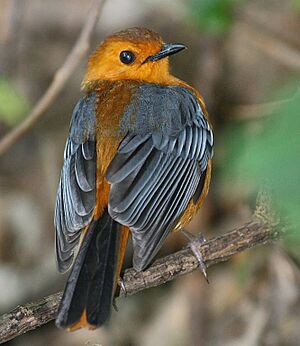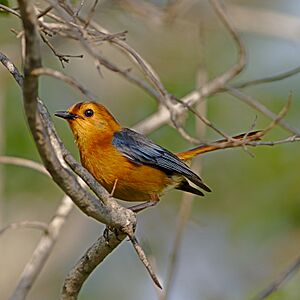Red-capped robin-chat facts for kids
Quick facts for kids Red-capped robin-chat |
|
|---|---|
 |
|
| In coastal KwaZulu-Natal, South Africa | |
| Conservation status | |
| Scientific classification | |
| Genus: |
Cossypha
|
| Species: |
natalensis
|
The red-capped robin-chat (also called the Natal robin) is a colorful bird found in Southern and Eastern Africa. Its scientific name is Cossypha natalensis. This bird is part of a large group of birds called passerines, which includes many songbirds. It belongs to the Muscicapidae family, known as Old World flycatchers and chats.
Contents
About the Red-capped Robin-Chat
How Scientists Name Birds
The red-capped robin-chat was first officially described in 1840. A Scottish zoologist and doctor named Andrew Smith gave it its scientific name. He found the first known bird near Port Natal in KwaZulu-Natal, South Africa.
This bird is part of the Cossypha group, also known as a genus. This group is part of the larger Muscicapidae family. This family includes many chats and Old World flycatchers.
Different Types of Red-capped Robin-Chats
The red-capped robin-chat has three main types, called subspecies. They are slightly different depending on where they live:
- Cossypha natalensis natalensis: This type lives in eastern South Africa. You can find it from the Eastern Cape to KwaZulu-Natal.
- Cossypha natalensis larischi: This type is found from Nigeria all the way to northern Angola.
- Cossypha natalensis intensa: This is the most widespread type. It lives in places like the southeastern Central African Republic, South Sudan, and southern Somalia. It also lives further south into Southern Africa.
What Its Name Means
The name Cossypha comes from an old Greek word. It means "blackbird" or "thrush." The second part of its name, natalensis, tells us where it was first found. It refers to "Natal," which is a region in South Africa.
Appearance and Sounds
The red-capped robin-chat is a medium-sized bird. It is about 15.5 to 19 centimeters (6 to 7.5 inches) long. Adult birds have a bright orange-red head, face, chest, and belly. They have a large, dark eye that stands out. Their wings and upper body are a dusky color. Their tail feathers are dark in the middle and bright orange on the outside.
Young red-capped robin-chats look different. They are mottled dark brown with reddish-brown spots on their heads. Their bodies have reddish spots that get bigger towards their belly.
Small Differences in Appearance
The main type, C. n. natalensis, has the look described above.
- The C. c. intensa type has a brighter reddish crown and nape (back of the neck). Its head and underparts are also a bit paler orange-red.
- The C.c. larischii type has slightly darker upperparts than the main type. This is especially true on its crown and nape. It also has a slightly shorter tail.
Bird Calls and Songs
The red-capped robin-chat makes a sad, shaky contact call. It also has other flute-like sounds, similar to other robin-chats. Its song is a long series of beautiful whistles. It often copies the sounds of other birds in its song.
Where They Live and Travel
Where to Find Them
Red-capped robin-chats live across a large area in eastern and southern Africa.
- C. n. larischi is found in central and southeastern Nigeria. It also lives in Cameroon, Gabon, and Angola.
- C.n. intensa is the most common type. It lives as far north as South Sudan and Ethiopia. It goes south to Zimbabwe and Mozambique.
- The main type, C. n. natalensis, lives in southern Mozambique, Eswatini, and parts of South Africa. This includes areas like Limpopo Province and KwaZulu-Natal.
Their Homes and Habitats
These birds prefer to live in the undergrowth of evergreen forests. This includes forests near the coast, along rivers, and in highlands. In summer, they might move into drier areas. They can be found in well-vegetated gullies and thickets. In KwaZulu-Natal, they are often seen in gardens with lots of shrubs.
How They Move Around
Red-capped robin-chats can stay in one place or move around. Young birds often travel a lot. Some northern populations in South Sudan are rare in winter. They return to their breeding areas in early March. They visit coastal areas in Tanzania and Mozambique during the dry season. In Zimbabwe, they are not found in higher areas from March to late August. They are known to be nomadic visitors in many places. Sometimes, they are seen in places they don't usually go, like Botswana.
Life Cycle and Habits
The red-capped robin-chat builds an open cup-shaped nest. It usually places the nest on a platform. The nest materials can vary a lot. They might use dead leaves, roots, twigs, grass, flowers, or even moss. Nests are often found in hollow tree stumps or cracks in branches. Sometimes they are in holes in dry gullies. Both the male and female bird help build the nest.
Reproduction and Family Life
These birds are monogamous, meaning they have one mate. They also defend their territory strongly. The breeding season changes depending on the area. It usually happens during the rainy season. They will fight other robin-chats to protect their space. This species is known to breed with the chorister robin-chat.
A female bird usually lays 2 to 4 eggs. She sits on the eggs by herself for about two weeks until they hatch. After hatching, the female keeps the young warm for about a week. The young birds leave the nest after 11 or 12 days. Sometimes, it can take up to 17 days. The young birds depend on their parents for about six weeks after leaving the nest.
The red-chested cuckoo is a brood parasite of the red-capped robin-chat. This means the cuckoo lays its eggs in the robin-chat's nest. The robin-chat then raises the cuckoo chick as its own.
What They Eat
Red-capped robin-chats eat both insects and fruit. They find insects by searching through leaf litter on the ground. Sometimes, they catch insects in flight or on tree trunks. They usually eat fruit from the tops of trees. They might also look for food near columns of driver ants. They also forage with other bird species. They have been seen catching insects that are disturbed by other birds or mammals.



